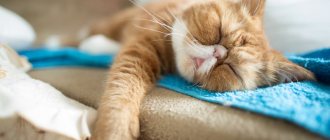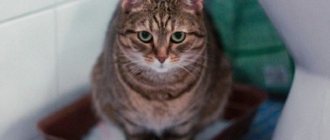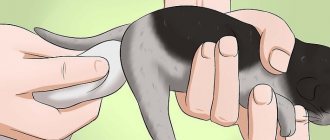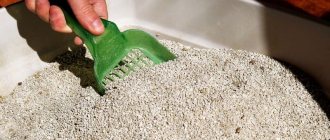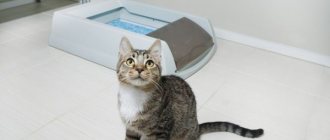Feeding rules
The first meal after castration should be no earlier than 20 hours later.
Previously not recommended as it may cause a gag reflex. If the pet refuses, then you should not force it. Food should be light and in small portions. Preferably in liquid form. Additionally, to restore water, you need to give as much fluid as possible. After the operation, dehydration occurs. Try to avoid overeating. It is recommended to limit consumption of: fish, salty, fried, smoked foods, baked goods.
Ensure that the menu includes: vegetables, hard-boiled eggs, cereals, lean meats, low-fat dairy products. Cat food manufacturers make special balanced food for neutered cats. They come in: dry, in the form of jelly, pates. They contain all the necessary microelements.
Recommended reading:
When to castrate a cat - what to pay attention to before the operation
If you give preference to dry food, then you need to constantly ensure that your pet drinks a lot.
After two days, the pet develops an appetite. You can give everything. But still, you shouldn’t overfeed him. As soon as the animal's strength is fully restored, it begins to eat a lot. And this threatens obesity and the appearance of diseases.
Dangerous conditions or complications
If the cat remains at home, then you need to monitor her very carefully and immediately contact the clinic in case of alarming symptoms:
- inability to go to the toilet three days after surgery;
- severe bleeding of the suture;
- an increase in body temperature (above 39 degrees) or a strong decrease (below 37 degrees) after a few days;
- swelling of the suture or its suppuration;
- depressed state of the animal;
- refusal of food and water even several days after sterilization;
- pale color of mucous membranes;
- abdominal pain and severe bloating.
What might the symptoms indicate?
- Pale mucous membranes in an animal may be a sign of internal bleeding.
- Symptoms may indicate that your cat has had a volvulus.
- Another complication is intestinal obstruction.
- The inflammatory process at the site of the suture can also cause complications.
Increased body temperature in a cat
A cat's natural temperature is 38 degrees, with the exception of hairless breeds, whose body temperature is 0.5 degrees higher. After sterilization, the body temperature may rise to 39.5 degrees for the first 5 days. You shouldn’t be scared - this is considered normal, because the animal’s body has undergone surgery.
A high temperature may indicate that an inflammatory process has begun in the animal’s body. There is no need to specifically lower your cat's body temperature - most painkillers have an antipyretic effect. If you have a high fever on the 6th day after surgery, it is better not to hesitate and consult a doctor.
For example, an animal’s elevated body temperature may mean that the doctor’s illiterate actions led to bleeding into the abdominal cavity. After the operation, the animal is very worried, refuses to eat, and does not lie on its stomach for more than 4 days. Only repeated surgery will help correct the situation; the doctor needs to remove blood clots in the abdominal cavity.
The use of collars and blankets in the postoperative period During the recovery period after surgery, it is recommended to use special attributes - collars and protective blankets. The collar is used on more aggressive and restless cats. It is used, in particular, to protect a fresh seam from being licked by a cat. The collar should fit in size and not cause suffocation or unpleasant, painful sensations. It is worth noting that not all cats like these types of collars, so it may take 1-2 days to get used to them.
Special protective blankets are more popular. They are used to tightly close the seam so that the animal cannot lick or scratch it. In addition, a blanket, if the size is chosen correctly, does not cause physical discomfort to the cat, unlike a collar. It is attached to the cat's body using ribbons - it is convenient to untie them for processing the seam. Excessive pressure on the scar and abdomen is also unacceptable. It is recommended to wear a blanket or collar for at least 10 days after surgery. After this period, the seam will heal, and the cat will no longer pose a danger to itself.
Making an Elizabethan collar for cats with your own hands
If you don’t have the opportunity to visit a pet store, and you need a protective cone yesterday, make it yourself. This does not require special talent, so anyone can cope with the task. You just need to follow the instructions, which explain in detail how to make a collar for cats with your own hands from cardboard, a plastic bottle and other materials that are at hand.
Made from cardboard - disposable
A disposable collar is suitable for the anti-flea procedure - to prevent the cat from scratching or licking the product. It is also useful for one-time manipulations. The maximum period for wearing a cardboard accessory is 3 days.
What you will need for production:
- 2 sheets of A4 cardboard;
- ruler;
- a compass or round object - for example, a jar lid;
- marker, pencil or pen;
- scotch;
- scissors.
The whole job will take no more than 5 minutes.
Step 1.
Prepare all the tools. Find the middle on the long side of the cardboard sheet.
Step 2.
Starting from the found middle, draw a semicircle using a lid or compass. The radius for a medium-sized cat will be 6 cm, but after trying on everything will be adjusted.
Step back about 10 cm from the inner semicircle and draw an outer semicircle.
Step 3.
Cut out the workpiece - it turns out to be ½ circle. Now, placing it on the second sheet of cardboard, outline and cut out ¼ of a circle.
Step 4.
Connect the cut with tape. You should have ¾ of a circle - that is, a full collar.
Step 5.
Try the collar on the animal.
If it’s too tight, move it a little away from the inner radius. Do not start with large numbers - often it is enough to step back from the edge by 0.5 cm. Step 6 .
Place the accessory on the animal and secure with tape.
Made from plastic - reusable
You can make a plastic protective product in exactly the same way. Plastic can be purchased at any office supply store. This collar is enough for several times of use, and even the most dexterous cat will not tear or remove it.
The only downside is that you can’t secure it with tape, so you’ll have to make holes and lacing (see below, in the section with the bottle).
From a bottle - in a hurry
A collar made from a five-liter bottle is used many times and is in no way inferior to a store-bought one. In addition, it is very durable - the cat will not be able to damage it and remove it. It will take 5-10 minutes to make.
What materials will you need:
- five-liter clean and dry bottle;
- marker - such that it does not rub off from the plastic;
- scissors;
- scotch;
- awl;
- ribbon or lace.
The operating procedure is as follows:
Step 1
Cut off the top of the bottle, leaving about 2 cm from the neck.
Step 2
Make a vertical cut. This will make it easier to cut off the bottom of the bottle later.
Step 3
Where the expansion of the bottle ends, cut off the bottom.
Step 4
Cover the inner side (the one that will be in contact with the cat’s neck) with tape so that the sharp edge does not injure him.
Step 5
Also, for safety reasons, round the corners on the outer edge where the cut goes.
Step 6
Make holes for the lace along both edges of the vertical cut. The optimal distance between them is 2-3 cm.
Step 7
Thread the ribbon or string through.
Step 8
Lace everything up well. Then loosen the lacing a little, put the collar on the cat and tighten the tape. Lacing directly on an animal is a disastrous idea.
From fabric
It is made on the basis of a pattern for a plastic cone, but requires fixing the shape. You will need to make a special cardboard frame or plastic insert to give the finished product stability. At the very end, cover the structure with linen or cotton fabric. You can make the protection softer by quilting the collar - using padding polyester or special materials.
This option puts virtually no strain on the neck, so cats quickly get used to it. If you don’t know how to sew, contact a craftsman you know or the nearest studio and ask to make a custom-made accessory.
Conclusion
A cat collar is a reliable means of protection that can be useful in many situations. When purchasing, consider safety and convenience, since aesthetic appearance is not at all important for the animal. But if your soul persistently demands beauty, make sure that the chosen option does not cause negative emotions in your pet, since it will be he who will wear it.
The article is a recommendation!
Toilet of a cat after castration
As a rule, cats go to the same place to go to the toilet after surgery. But since it will be difficult for your pet to move after anesthesia, place the tray next to him. If an animal goes past the toilet, there is no need to scold it, since castration is stressful for it. And raising your voice will negatively affect your recovery. Until the scars are completely healed, use mineral litter for the toilet. This will give confidence that the animal will not be injured by coarse fibers.
Synthetic fillers can also cause irritation on a cat's operated skin. It is better if it is light shades. After each visit, try to clean the tray and check that there is no blood. Bleeding is a reason to visit a doctor. The presence of slight bleeding is allowed only in the first postoperative days. If your urine has changed color, then also go to the doctor immediately. A clean toilet will prevent harmful bacteria from developing.
Recommended reading:
How much does a neutering procedure cost for a cat?
The cat does not walk much after castration, what should I do? This phenomenon is rare, but it happens. Therefore, contact your veterinarian, he will prescribe a laxative, provided that the animal has not had a bowel movement for 24 hours. Quite often, animal lovers advise giving a few drops of Vaseline oil. It not only stabilizes the stool, but also helps urine flow.
It is considered normal if the cat does not go to the toilet until 2 days after surgery. This is due to the fact that the body has suffered stress. At first, the urine will have a strong odor, but this will go away within a month.
If all else fails and the animal cannot go to the toilet, get examined immediately to rule out serious illnesses.
Rules of care in the first postoperative hours
The operation itself is not complicated, but the postoperative period is different for each pet. It is done under general anesthesia. It is difficult to say exactly how the animal’s body will react to the medicine and procedure.
But to alleviate the animal’s condition, it is recommended to do the following:
- Covering the cat's eyes is done to prevent the mucous membranes of the eyes from drying out. During the wearing off of anesthesia, cats cannot do this on their own, and quite often conjunctivitis develops during this period.
- Put it in a warm, comfortable place - this way your pet will feel safe. It is advisable that the bed be located near the heater, on the floor and be soft. Place a bowl of water nearby. You should not feed it, as your pet may feel nauseous after anesthesia.
- Since every movement is difficult for the animal, shift it yourself from one side to the other so that there is no stagnation of blood.
- Check his reaction to external stimuli more often.
- Talk to him and stroke him gently. The voice should be smooth and soothing.
- Ensure minimal movement and remove all obstacles as much as possible. During this period, the cat's movements are unbalanced, and he may get hurt.
- It is advisable to carefully observe the animal. If he does not get up for a long time and his gaze is focused on one point, this means that he is in pain. Ask your veterinarian for a prescription for painkillers right away.
Recommended reading:
Caring for a cat after sterilization - the best advice from veterinarians
Proper care during rehabilitation helps the animal endure this process more easily.
The cat's seam came apart after sterilization
A tiny cosmetic stitch after sterilization of a cat normally heals quickly without a trace. However, this is not always the case. Sometimes owners are forced to return to the clinic again because the cat’s stitch has come apart after sterilization.
The most common cause of this problem is neglect of the veterinarian's recommendations. If after surgery the cat does not wear a collar or blanket, it will tend to lick the stitches.
Together with saliva, an infection enters the wound, and severe inflammation (festering) of the suture occurs. In this case, no threads will hold the fabric together. In addition, with its rough tongue, a cat can get rid of stitches ahead of time.
If the suture discrepancy is minor, the doctor may prescribe “conservative” treatment. First of all, you need to stop the seam from licking. Then local blockades are made (Novocaine 0.5% with an antibiotic), the wound is washed 1-2 times a day. Sometimes healing ointments and preparations such as Vinilin are used. Treatments sometimes last a long time, 1-2 weeks, so I urge owners to take care of the suture immediately after surgery to avoid such problems.
Minor divergence of the cosmetic seam (the cat was not wearing a blanket)
If the suture is severely torn, the only treatment option is surgical revision of the suture under general anesthesia. The doctor will remove non-viable tissue and sew up the belly again. In this case, removable external sutures are usually placed and a systemic antibiotic is prescribed. Case from practice:
The cat was sterilized in a third-party clinic, the external and internal seams were made with silk, the cat did not wear a blanket
Severe seam divergence, 3 weeks have passed since sterilization
All non-viable tissue was removed and sutures were re-sutured.
The same cat after removal of stitches (12 days after wound revision)
Dangerous conditions
Particular attention should be paid to cases when a cat, after sterilization, does not urinate at all for more than a day and cannot “go big” for more than three days. If, in addition to this problem, there are other dangerous signs, you should immediately contact a veterinarian:
- suppuration or inflammation of the suture;
- temperature increase on the third day after sterilization from 39°C or more;
- temperature drop to 37°C or less;
- restless behavior of the pet;
- refusal to eat and drink for more than a day;
- hard, painful stomach.
Possible complications in this case may be intestinal obstruction, volvulus, internal bleeding or inflammation at the site of the suture. Such consequences after sterilization occur quite rarely.
An unfavorable course of the postoperative period may be the result of improper work by the surgeon, the use of unsterile instruments, dirt getting into the suture area, or an animal licking the wound. To avoid serious complications, it is recommended not to remove the blanket from your pet for a week.
In general, when a cat does not go to the toilet after sterilization, most often nothing needs to be done. You just need to wait until she comes to her senses, and on the second day the stool usually returns to normal.
You should not self-medicate - if alarming symptoms appear, it is important to contact a specialist in time for help.
Dogs after sterilization and castration
Some dogs recover quickly on their own, but there are ways you can make the healing process easier.
What do you need to remember after your dog has been spayed?
After your dog is home from surgery, you may notice that he is disoriented or more depressed than usual. It is not uncommon for a dog to be especially quiet during the first 24 hours after surgery. If for some reason your dog is agitated, you should confine him to space. Especially in the case of females, who have a higher chance of the seams coming apart.
During the recovery process, place your dog in a quiet area with dim lighting. The sleeping place should be comfortable and the temperature in the room should be pleasant. Also, if you have other pets or children, keep them away from your dog. During the recovery period, your dog may experience some confusion and may become aggressive.
The anesthetic effect usually wears off completely after 24 hours. After this period, your dog should behave as normal.
Eating food and water after spaying or neutering
As soon as your dog gets home from the vet, you can offer him some water. First of all, don't let your dog drink too much as this can cause vomiting. When your dog is awake and active, you can offer him a small amount of food (half the normal amount). If your dog is vomiting or refuses to eat at all, don't force it. Wait until the next day and you can offer food again.
One day after surgery, you can offer water and food in the usual quantities. On the first day, your dog's appetite should not be the same as usual. However, if things do not return to normal within the first 48 hours after surgery, you should call your veterinarian.
In addition, it will be better for your pet to continue to eat food for sterilized animals. It contains the necessary substances in the right ratio.
Will the animal be able to go to the toilet normally after surgery?
During the first time after anesthesia, most often several hours, the control of urination and defecation is impaired in animals; the best solution would be to place an absorbent diaper under the pet.
If your dog does not go to the toilet regularly within three days after surgery, you should contact your veterinarian.
Check to see if there is blood in your dog's urine. A small amount may be present in bitches the first day after surgery. If this continues longer or if your dog seems to be in pain, contact your veterinarian.
Animal activity levels after sterilization
Within a day or two of spaying/neutering, your dog should be back to normal. You should still limit your dog's activity for a week after surgery.
Too much activity can cause the stitches to come apart or become inflamed at the surgical site.
How can you help your pet feel calm after surgery?
Limit the areas in your home that your dog has access to. Keep your dog in a closed room or appropriately sized crate when you are unable to control the restraint. The dog must be able to stand up and turn around inside the crate.
If there are steps and if your dog is small, carry him up and down the stairs in your arms.
Always walk your dog on a leash for short periods of time and do not allow him to play rough with other animals or people. Also, don't let your dog jump up or down on the couch.
Dangerous conditions or complications
Attention!
The first few days after sterilization, it is necessary to monitor the animal’s condition very carefully. The best way out of the situation would be to leave the cat under the supervision of veterinarians.
If the cat remains at home, then you need to monitor her very carefully and immediately contact the clinic in case of alarming symptoms:
- inability to go to the toilet three days after surgery;
- severe bleeding of the suture;
- an increase in body temperature (above 39 degrees) or a strong decrease (below 37 degrees) after a few days;
- swelling of the suture or its suppuration;
- depressed state of the animal;
- refusal of food and water even several days after sterilization;
- pale color of mucous membranes;
- abdominal pain and severe bloating.
What might the symptoms indicate?
- Pale mucous membranes in an animal may be a sign of internal bleeding.
- Symptoms may indicate that your cat has had a volvulus.
- Another complication is intestinal obstruction.
- The inflammatory process at the site of the suture can also cause complications.
READ How to help a cat after sterilization
Important!
If you notice any symptoms, do not delay and take the cat to the veterinary clinic, because she needs urgent help!
If a cat has diarrhea, then a completely different approach to solving the problem is needed. Recognizing diarrhea is not at all difficult, because its main difference is liquid feces.
If your pet has diarrhea, you need to take it to the veterinarian. He will measure the animal’s body temperature, determine the degree of dehydration, and palpate the tummy and internal organs. In addition, the clinic will perform some tests:
- examination of urine and feces (for the presence of worms, for hidden bleeding);
- blood analysis.
In some cases, it is enough to provide the cat with rest and keep it on a starvation diet for one day.
If a cat experiences fluid loss, it must be replenished through intravenous drips or oral administration. When feeding, you need to follow a diet, and the portion of food should increase gradually.
If diarrhea is a consequence of an infection introduced during sterilization, then in addition to all the above actions, special treatment is also included, which is prescribed by the doctor.
If the following symptoms are detected while caring for your cat, you should immediately contact a veterinarian:
- Heartbeat disturbance.
- Breathing disorders. The appearance of wheezing during breathing.
- Swelling of the tongue or eyelids.
- Excessive pallor or brightness of the mucous membranes.
One of the important factors is to provide the pet with complete peace, silence, and isolation from other animals during care. Carefully take care of the wound and the toilet, and then he will quickly recover and will delight you with an attractive and healthy appearance.
Possible postoperative complications
Immediately after sterilization, ichor and a small amount of blood will be released from the suture. Small bruises and bruises may appear on the skin near the suture - this is a natural process after surgery. The seam itself looks like a red roller, rising above the level of the skin. Surgical threads may also be visible from it. Immediately after arriving home, it is recommended to apply ice wrapped in a clean scarf to the seam.
After 2 days after sterilization, the seam must be treated with disinfectants. A solution of chlorhexidine or miramistin is suitable. Using a cotton swab soaked in solution, you need to carefully treat the seam area, clean it of dirt and hair.
Attention! To avoid burns, it is forbidden to use iodine and brilliant green!
The approximate course of treatment of a postoperative scar after sterilization is 10 days. Treatment frequency: 2 times a day. If after 5 days the seam is still wet and inflamed, then you should immediately seek help from a veterinarian - it is often necessary to additionally treat the cat’s stomach with an antibacterial ointment, for example, levomekol.
Complications after planned surgical interventions develop extremely rarely and, in most cases, it depends on the individual characteristics of a particular animal.
- Prolonged post-anesthesia hypothermia. If a cat lies for a long time without moving, and its ears and paws feel cold to the touch, it is necessary to check its body temperature. If the readings are below 37°C, you need to put the cat on a warm heating pad, cover it with any natural piece of fabric and contact your veterinarian for advice.
- Intra-abdominal bleeding. If traces of fresh blood are detected in the suture area or from the vulva, with obvious pain in the abdomen and pallor of the skin, you should immediately take the cat to a veterinary hospital to stop possible bleeding in the abdominal cavity. If internal bleeding is confirmed, then repeated surgery is performed.
- Postoperative hyperthermia. If body temperature is elevated for more than 3 days (above 39°C), it is necessary to consult with a veterinarian or take the cat to an appointment for direct examination by a specialist.
- Redness around the stitch and swelling. This condition of the suture is allowed for 3-5 days, provided that there is no discharge from the wound. After 5 days, both redness and swelling will begin to subside and will completely disappear by the time the stitches are removed.
- Rotting postoperative suture. If the cat's postoperative hygiene measures are not followed, dirt may get into the seam, causing it to fester. It is imperative to show the animal to a doctor. If the prescribed drugs for local treatment do not help eliminate such signs, the doctor will have to remove the stitches, remove the damaged areas of skin around the wound under anesthesia and re-suture it.
- Lump on the abdomen in the suture area. If an enlarged area is detected anywhere around the seam, this is a reason to consult a veterinarian. There are two options for lumps after sterilization - this is post-operative swelling, which may have to be opened, or the growth of granulation tissue (“young” skin), which will go away on its own within a month and a half.
Animal food
In the first postoperative hours, your pet's appetite will be reduced; there is no need to force-feed the cat. It's okay if your pet doesn't eat on the first day. The care required is the availability of water. It must be in sufficient quantity.
Veterinarians recommend that after castration, feed the animal dry food, which acidifies urine and is a prevention of urolithiasis. A pet who eats dry food must drink more fluids, otherwise he will have difficulty going to the toilet. To one part dry food there should be three parts water. If he rarely goes to the toilet for a little while, then you should contact the veterinarian, he will prescribe diuretics.
A neutered pet constantly begs for food, but this does not mean that he is hungry. You should not follow his lead, otherwise obesity may develop.
What to do at home if your cat can't pee
The first thing to do if your cat cannot go to the toilet is to take him to the clinic. The doctor will be able to quickly assess the danger of the situation and take radical measures to alleviate the animal’s condition.
First aid
But sometimes circumstances develop in such a way that it is not possible to quickly bring your pet to the hospital. In this case, you should know what to do and how to provide first aid at home to a cat who cannot pee.
To relieve spasm and relax the smooth muscles of the ureters and bladder, male cats should be given an intramuscular injection of No-shpa or Papaverine.
Important! If a cat rarely goes to the toilet or has completely absent urination for more than a day, then giving diuretics is strictly prohibited.
If the cat cannot pee, then as therapy at home you can treat it with Cat Erwin, and also inject it with an antibacterial drug (Tsiprolet, Baytril).
This will help relieve spasm and reduce inflammation for a short period of time. This period should be used to take the cat to the clinic or call a veterinarian at home.
Important! You shouldn’t try to do something on your own if the cat hasn’t been able to pee for 2 days or is screaming in pain or won’t let you touch her belly. In this case, only immediate catheterization can save her from death.
Veterinarian actions
After examining the cat and making a preliminary diagnosis, the veterinarian carries out treatment. It can be roughly divided into 4 stages:
- Preventing stretching and rupture of the bladder in a cat or cat that has not gone to the toilet for more than two days. To do this, a soft catheter with an attached closed system for collecting urine is inserted into the animal. For sterilized cats that periodically cannot pee after castration, a temporary catheter is placed. This is necessary to reduce the risk of developing ascending bacterial infections.
- Stimulation of the bladder muscles. The most effective drug for this is Bethanechol. However, multiple side effects and the need for urgent administration of an antidote in case of intolerance make it possible to use it only in a hospital setting, under the strict supervision of a physician. Cisapride and Propanolol are considered safer drugs for cats. But their independent administration is also prohibited.
- Decreased tone of the urethra and bladder neck. If the obstruction is not associated with anatomical developmental abnormalities, then a cat who has stopped peeing and does not recover for a long time after catheterization is prescribed muscle relaxants (Acepromazine, Diazepam) and alpha-adrenergic antagonists (Phenoxybenzamine, Prazosin).
- Prevention of the development or relief of infectious processes in the lower urinary tract. They often cause systemic inflammation, which can be fatal. Therefore, a veterinarian must prescribe antibacterial drugs to a cat that has not gone to the toilet for the second day or more than 2 days.
Note! The optimal way to select antibiotics is to conduct a preliminary bacteriological study of urine to determine the sensitivity of pathogenic microorganisms to certain drugs. In this case, you can achieve effective results and spend less time treating a cat that cannot pee.
Treatment options
At home, it is impossible to diagnose and carry out full effective treatment for a cat that cannot pee in the litter box on its own. This is due to the fact that in addition to conservative methods of therapy, surgical intervention is often used to eliminate this syndrome.
The most common indications for surgery in cats are malignant and benign tissue growths, as well as urolithiasis. A somewhat less common reason for performing surgery on a cat that rarely goes to the toilet is anatomical anomalies in the structure of the organs of the genitourinary system.
Injections (tablets, drops) against cat walking
Details
Injections (tablets, drops) to prevent the cat from wandering.
The Kotofey veterinary clinic received a cat that the owners found in the barn. In their opinion, the cat went to die. Before this, she completely refused to eat. Upon examination, it was determined that the cat was experiencing severe pain in the abdominal area and a slightly elevated temperature (39.4 degrees). When interviewing the owners, it was found that 4 months ago the cat was given an injection of a hormonal drug to prevent sexual heat, “since the cat constantly gives birth.” The owners complain that “The cat is constantly yelling, what should I do?” Previously, similar drugs were also used: “anti-bulk tablets” and “anti-bulk injections”. As you know, the only effective drugs on our market are those whose action is based on the correction of hormonal levels. However, the simplicity and relative cheapness of using these drugs has a downside: gynecological disorders in the functioning of organs and, as a result, ovarian cysts, neoplasms on the uterus, pyometra (purulent endometritis), tumors of the mammary glands, which further spread to other organs and tissues of the animal. The cat was successfully operated on in our clinic and she successfully completed the postoperative period.
In this article, we have prepared photographic materials taken during surgical interventions at the Kotofey veterinary clinic. The photographs illustrate what diseases occur in animals and what doctors have to deal with after the owners use hormonal drugs to regulate sexual heat.
Remember that if “the cat yells, meows, asks for a cat”, do not use “anti-buzz pills” under any circumstances. If your cat is yelling, contact your veterinarian. The best way out of this situation, if you do not plan to nurse kittens, is sterilization. Sterilization of a cat at the Kotofey veterinary clinic has very good statistics and, as a rule, takes place without complications. In addition, we are constantly improving our work day after day. Minimal trauma, quick recovery from anesthesia, good health after surgery, an easy postoperative period - this is the reality of the work of our veterinarians.
So, let's start looking at the photo report.
A tumor of the milk sac in a cat, formed as a result of hormonal disorders. Removal of a tumor of the milk sac in a cat at the Kotofey veterinary clinic is carried out without blood loss.
Numerous cysts on the uterus of a cat. They can be removed exclusively through surgery. As a rule, an ovariohysterectomy (sterilization) is performed with the removal of the uterus and ovaries.
For comparison, pay attention to what a healthy uterus and ovaries should look like in a cat in the article about purulent inflammation of the uterus (pyometra) on our website: https://kotofey.dp.ua/cure/66-pyometra
Here is another photo of numerous cysts on the cat’s uterus:
An unusual case: a very large number of cystic neoplasms on the cat’s uterus. After the operation, the cat felt much better the very next day. The disease caused the cat severe pain and poor health.
The internal contents of the uterus are not a sight for the faint of heart: frozen kittens at the stage of decomposition. The bones of unborn kittens are laid out just above

